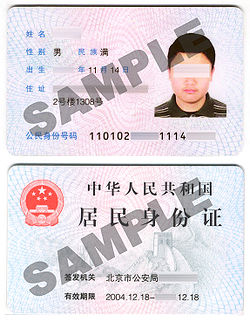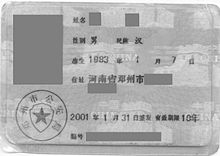Match a Resident ID number with the registered residence and birth date of its holder:

|
| A sample of latest Chinese citizen ID card |

 Guangdong
Guangdong Zhejiang
Zhejiang Fujian
Fujian Jiangsu
Jiangsu Sichuan
Sichuan Shandong
Shandong Liaoning
Liaoning Yunnan
Yunnan Xinjiang
Xinjiang I. Mongolia
I. Mongolia Tibet
Tibet Beijing
Beijing Hebei
Hebei I. Mongolia
I. Mongolia Shanxi
Shanxi Tianjin
Tianjin

|
| A sample of latest Chinese citizen ID card |
Every citizen of 16 years old or above in the People's Republic of China shall have a Resident Identity Card , in accordance with the Identity Card Bill of the People's Republic of China passed On September 6, 1985 by the Standing Committee of the 12th National People's Congress.
Residents within the People's Republic of China must carry identification in public at all times, compulsory from the age of 16. The identity card is the only acceptable legal document to obtain resident permit, employment, open bank accounts, obtain passport, driver licence, application for tertiary education and technical colleges, security checkpoints in domestic terminals of Chinese airports and check-in at hotels. Documentation is also required for marriages, household registrations and legal cases.
Recently, there have been more services that require the display of identification cards, such as at Internet cafes and certain stores.
Before 2003, Chinese use a poly-covered, white-and-black photo Identity Card, which is now referred to as the first generation ID card. From 2003 on , The law established the use of newer, second-generation cards, which are machine-readable and more difficult to forge.
Contents The identity card contains basic information regarding the individual, such as the following: Full name – in Chinese characters only. Non-Chinese ethnic names and foreign names are transliterated into Chinese. Gender – containing one character for either male (男) or female (女). Ethnicity – as officially listed by the People's Republic of China. Date of birth – listed in the Gregorian calendar format, in YYYY年MM月DD日 Big-endian (ISO 8601) order. Domicile – the individual's permanent residence as dictated by the Identity Card Bill of the People's Republic of China. Identification number Photo of the individual Reverse side Issuing authority (first-generation cards utilised a stamp; second-generation cards display text only) | |
| Second-generation Identity Card | |

|
|
| First-generation Identity Card |
The limits to validity of the document (for individuals under 16 years of age: five years; for individuals between 16 and 25 years of age: ten years; for individuals between 26 and 45 years of age: twenty years; for individuals over 46 years of age: long-term)
Information stored in the identity database for biometric ID cards documents information such as work history, educational background, religion, ethnicity, police record, medical insurance status, landlord's phone number and personal reproductive history.
The dimensions of the second-generation cards are 85.725 mm×53.975 mm×0.900 mm, and the identity photo is sized at 358x441 pixels (width by height), printed at a resolution of 350dpi on RGB using 24-bit True Color, prepared using JPEG compression techniques in line with the requirements of ISO DIS 10918-1. The final image appears as a 26 mm × 32 mm portrait box in the top-right hand corner.
Identity card number
From October 1, 1999, the PRC State Council approved the establishment of a citizen identification number system, and currently consists of an 18-digit code.
1 1 0 1 0 2 Y Y Y Y M M D D 8 8 8 X
Address code Date of Birth code Order code Checksum
Address code refers to the resident's location, where administrative divisions (including cities, banners, and districts) have their own specific codes. (For example, the code for Xicheng District in Beijing is 110102.)
Date of Birth in the form YYYY-MM-DD.
Order code is the code used to disambiguate people with the same date of birth and address code. Men are assigned to odd numbers, women assigned to even numbers.
The Checksum is the final digit, which confirms the validity of the ID number from the first 17 digits, utilizing ISO 7064:1983, MOD 11-2. The checksum is obtained by a complex equation.
| Province | Adm. Code | Province | Adm. Code | Province | Adm. Code | |||
| Anhui | 340000 | Beijing | 110000 | Fujian | 350000 | |||
| Gansu | 620000 | Guangdong | 440000 | Guangxi | 450000 | |||
| Guizhou | 520000 | Hainan | 460000 | Hebei | 130000 | |||
| Henan | 410000 | Heilongjiang | 230000 | Hubei | 420000 | |||
| Hunan | 430000 | Jilin | 220000 | Jiangsu | 320000 | |||
| Jiangxi | 360000 | Liaoning | 210000 | Inner Mongolia | 150000 | |||
| Ningxia | 640000 | Qinghai | 630000 | Shandong | 370000 | |||
| Shanxi | 140000 | Shaanxi | 610000 | Shanghai | 310000 | |||
| Sichuan | 510000 | Tianjin | 120000 | Tibet | 540000 | |||
| Xinjiang | 650000 | Yunnan | 530000 | Zhejiang | 330000 | |||
| Chongqing | 500000 | |||||||
 Nansha District Sports Center
Nansha District Sports Center
 New Tianhe Hotel
New Tianhe Hotel
 Gongyuanqian Operation Department, Guang
Gongyuanqian Operation Department, Guang
 VIP Home(Tianhe Branch)
VIP Home(Tianhe Branch)
 Aoke Wude Restaurant
Aoke Wude Restaurant
 Laike Restaurant
Laike Restaurant
 Duobao Restaurant(Duobao Road Branch)
Duobao Restaurant(Duobao Road Branch)
 Shengang Restaurant Shigongyu
Shengang Restaurant Shigongyu
 General Office of The State Council
General Office of The State Council
 Ministry of Foreign Affairs, P.R.C.
Ministry of Foreign Affairs, P.R.C.
 Ministry of National Defense, P.R.C.
Ministry of National Defense, P.R.C.
 National Development and Reform Commissi
National Development and Reform Commissi
 Ministry of Education, P.R.C.
Ministry of Education, P.R.C.

